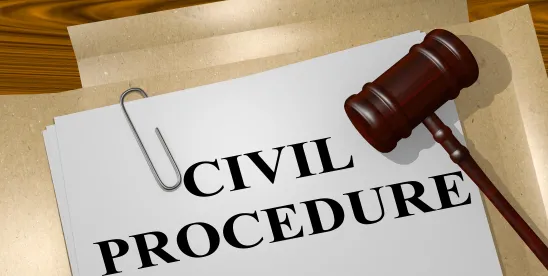Earlier this year, the Court of Appeals for the Ninth Circuit issued its decision in Lytle v. Nutramax Labs, Inc., finding that a class action plaintiff may rely on a model to demonstrate that damages are susceptible to common proof, even if the model had not yet been executed or actually applied to the proposed class. 2024 WL 3915361, *2 (9th Cir. 2024). In doing so, the Ninth Circuit joined several other courts in affirming that plaintiffs need only show that damages are capable of being measured to survive class certification. Id. at *4. In other words, the Ninth Circuit found plaintiffs may, in appropriate circumstances, satisfy their burden at the class certification stage through a "proffer of a reliable method of obtaining evidence that will come into existence once a damages model is executed." Id. at *6. This was despite the requirement that before certifying a class, a district court must conduct a "rigorous analysis" of whether the prerequisites of Federal Rule of Civil Procedure (FRCP) 23 have been satisfied under a preponderance of the evidence standard, including the predominance requirement that "questions of law or fact common to class members predominate over any questions affecting only individual members." FRCP 23(b)(3).
While the Lytle decision at first blush might suggest that at the class certification stage a plaintiff's burden to show potential class-wide damages is easily satisfied, that is not the case. In fact, a close read of the Lytle case provides helpful context for the hurdles plaintiffs face and how defendants can effectively defeat class certification based on the failure of a putative plaintiff to set forth a sufficient damages model.
Background
In Lytle, Plaintiffs brought a putative consumer class action against Nutramax Laboratories, Inc. and Nutramax Laboratories Veterinary Sciences, Inc. (collectively, Nutramax). Plaintiffs alleged that Nutramax violated the California Consumers Legal Remedies Act when it marketed a pet health product, Cosequin, as promoting healthy joints in dogs, even though Cosequin allegedly provided no such health benefits. Lytle, 2024 WL 3915361 at *2.
Plaintiffs' expert proposed that a "conjoint survey" be applied to establish damages on a class-wide basis. Id. at *4. Critically, the Plaintiffs' expert had not yet surveyed any class members, calculated what the class members' damages might be, or otherwise applied his damages model to a representative sample of the class. Id. Instead, the expert had merely opined that his analysis of market data and the marketing documents shared through discovery suggested that a conjoint survey would be "well-suited to the facts of this case" and would "successfully isolate the economic damages associated with the Challenged Claims." Id. The expert "acknowledged, however, that he would not know whether the class actually suffered any damages until he actually executed his survey." Id. at *4. The district court nonetheless certified the class.
On appeal, Nutramax challenged the certification, arguing that the rigorous analysis required by FRCP 23 prohibited class-action plaintiffs from relying on an unexecuted damages model to demonstrate predominance. Id. In particular, Nutramax asserted that the Supreme Court's decision in Comcast Corp. v. Behrend, which held that "a class action plaintiff must 'establish[] that damages are capable of measurement on a classwide basis," meant that plaintiffs had to proffer "admissible, affirmative evidence that classwide injury and damages in fact are capable of classwide measurement" to satisfy the predominance requirement. Id. at *6 (emphasis in original).
The Ninth Circuit rejected Nutramax's argument, explaining that while Comcast demanded some assessment of the adequacy of the plaintiffs' common proof at class certification, it did not require that plaintiffs "actually prove damages at the class certification stage [nor] prohibit[] Plaintiffs from relying on an unexecuted but reliable damages model." Id. at *8 (emphasis added). Instead, under a limited Daubert analysis, the Ninth Circuit affirmed the district court's grant of class certification because there was "no dispute that a conjoint analysis is capable of measuring classwide damages," no challenge by Nutramax to the expert's credentials, and no showing by Nutramax that the expert's methodology was flawed or would be improperly applied.1 Id. at *12-13, 17. Other cases in other circuits, pre- and post-Comcast, have had similar holdings. See, e.g., Forsythe v. Teva Pharm. Indus. Ltd., 102 F.4th 152, 159 (3d Cir. 2024) (holding that the proposed damages model was consistent with the theory of liability and agreeing with lower court assessment that "any questions of 'loss causation' or the 'disaggregati[on of] confounding factors to prove economic loss' need not be determined at the class certification stage."); In re Ethylene Propylene Diene Monomer (EPDM) Antitrust Litigation, 256 F.R.D. 82, 100 (D. Conn. 2009) (granting class certification and observing the question before the court was whether "plaintiffs have established a workable multiple regression equation, not whether plaintiffs' model actually works") (emphasis in original).
Ramifications
Decisions like Lytle may make a defendant feel as though it is fighting class certification with one arm tied behind its back. While understandable, that sentiment overstates the impact of Lytle and other similar cases. To be sure, in an unexecuted damages model scenario, the district court is necessarily "limited at class certification to making a predictive judgment about how likely it is the expert's analysis will eventually bear fruit." Lytle, 2024 WL 3915361, at *11. With no model outputs to assess, the court's inquiry is inevitably going to be more constrained. See, e.g., Orshan v. Apple, Inc., 2024 WL 4353034, at *2 (N.D. Cal. Sept. 30, 2024), quoting Lytle, 2024 WL 3915361, at *11 ("Where an expert … 'has not [yet] collected all of the necessary data to perform his calculations,' courts perform only a limited Daubert analysis focused on the expert's methodology, leaving a 'full-blown Daubert assessment' of the expert's results for another time."). Nevertheless, the Lytle decision provides several helpful strategic insights for defendants opposing class certification on predominance grounds where the plaintiff's expert relies on an untested model or methodology to demonstrate that damages are susceptible to common proof.
First, although in Lytle the damages model had not been executed to demonstrate class-wide impact, the decision should not be interpreted to mean that a plaintiff will never need to have its expert execute a damages model before satisfying the predominance standard for class certification. Indeed, the Ninth Circuit was clear that despite not "categorically requir[ing] an expert to execute the expert's model before it may be relied upon," an unexecuted expert's model remains "one factor that must be considered" in the certification analysis. Lytle, 2024 WL 3915361, at *9 (emphasis added) ("To be sure, the fact that the model has not been executed remains relevant.") Id. at *12. Plaintiffs, therefore, still need to satisfy Rule 23 by demonstrating "that damages could be calculated on a classwide basis" and that "the method of proof would apply in common to all class members" and predominate over individual issues. Id. at *7 (emphasis in original). Accordingly, the plaintiff's failure to include its damages model output can still be an important weapon for defeating class certification if it leaves significant doubt as to the reliability of the model and "whether the model will likely be able to generate common answers at trial." Id. at *13.
Second, even with the more limited scope of review, there are still multiple ways a defendant can defeat class certification based on a lack of predominance when facing an untested damages model. In Lytle, for example, the Ninth Circuit noted that "[m]erely gesturing at a model or describing a general method will not suffice," and that a novel methodology, as opposed to a well-accepted modeling approach, will "demand a greater degree of specificity and completeness [from plaintiffs] before it is relied upon to certify a class." Id. at *13. Credible evidence that there is insufficient data available to run the proposed damages model effectively is another basis to potentially defeat class certification. See id. ("Plaintiffs — or their expert — must chart out a path to obtain all necessary data and demonstrate that the proposed method will be viable as applied to the facts of a given case."). In addition, observable errors in the underlying proposed model or methodology itself remain a powerful tool for a defendant to defeat class certification by showing that the model cannot reliably measure damages on a class-wide basis. See, e.g., Orshan v. Apple, Inc., 2024 WL 4353034, at *3 (rejecting one of the plaintiff's untested damages models at class certification stage because it was premised on a faulty valuation assumption). In this regard, the Lytle court noted that Nutramax raised a "flurry" of attacks on the reliability of the plaintiff's model for the first time on appeal, arguments that the district court was never presented with and thus were not considered by the Ninth Circuit. Lytle, 2024 WL 3915361, at *13. Taken together, these various avenues of attack demonstrate that defendants confronting an unexecuted damages model should focus on incorrect assumptions or defects baked into the model, as well as challenging the appropriateness of the proposed methodology itself rather than any speculative output the model may produce. See, e.g., In re Ethylene Propylene Diene Monomer (EPDM) Antitrust Litigation, 256 F.R.D. at 96 ("defendants should be focused on disputing the use of the methodology itself, not the results of the methodology.")
Lastly, even if the plaintiffs are able to achieve class certification, defendants may nonetheless test the sufficiency and reliability of any damages model proffered by a plaintiff's expert at a later stage, once the damages model is "fully executed," either through summary judgment motions or Daubert motions. Lytle, 2024 WL 3915361, at *14. As the Lytle court articulated, this will ensure "that a plaintiff may not avoid ultimate scrutiny of the admissibility of their experts' final opinions simply by declining to develop those opinions in advance of class certification." Id.




 />i
/>i

